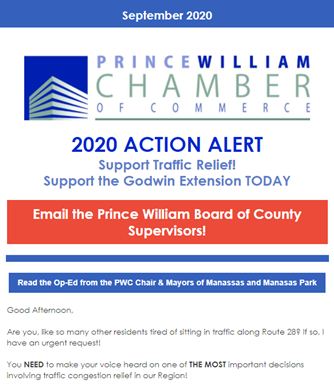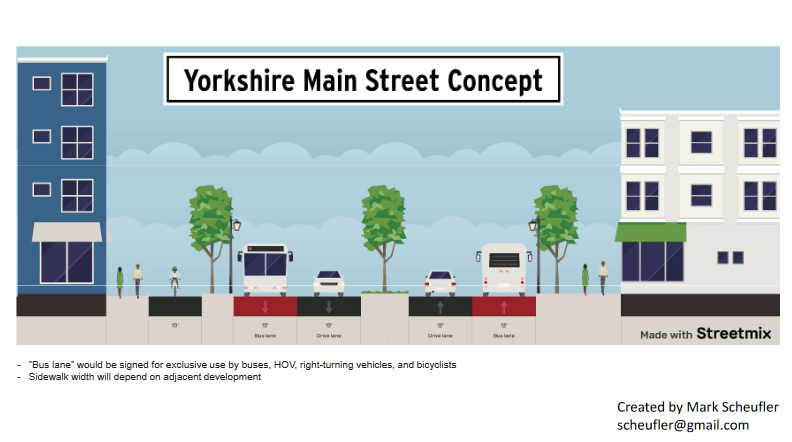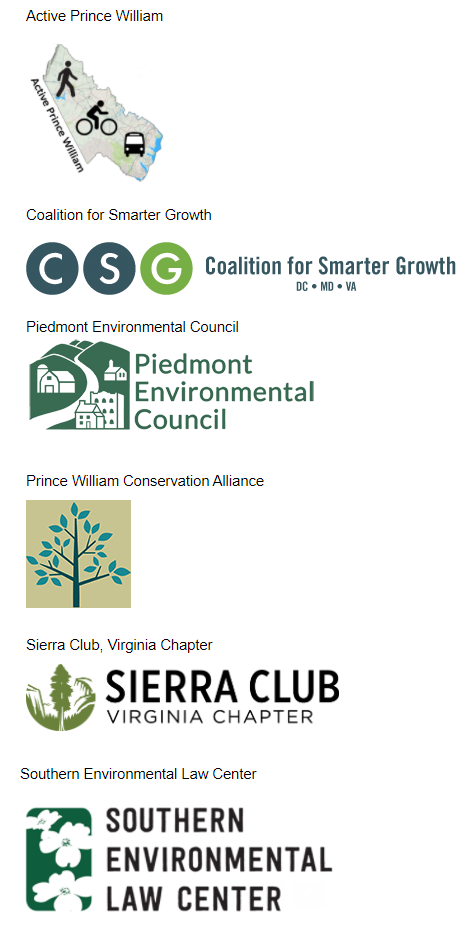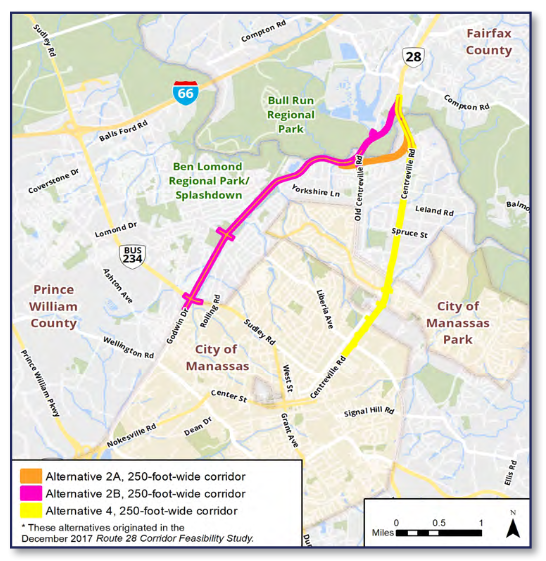
The Chamber of Commerce is pressuring the Prince William supervisors to overturn their 8-0 vote on August 4 to improve traffic on Route 28. The supervisors unanimously adopted Alternative 4, after rejecting the staff recommendation for the Godwin Drive extension (Alignment 2B).
You can see the decision process at https://pwcgov.granicus.com/MediaPlayer.php?view_id=23&clip_id=2751&meta_id=65343
Below is a rebuttal by Active Prince William to claims made by the Chamber. There is a similar rebuttal to previous claims made by the Northern Virginia Transportation Alliance, the lobby group for road builders and land developers, at https://www.activepw.org/wp-content/uploads/nvtaresponse-7-28-20.pdf
The developers and business lobbyists are making claims that are not valid, or are incomplete and misleading. Get the rest of the story, below.
—————————————————————————————————————————————
Chamber of Commerce claim:
If the vote is not reconsidered at the September 8th Meeting, then we are delaying this project by at least another DECADE, impacting over 70+ businesses who will be forced to close down and their employees left unemployed and, it will COST AT LEAST $100 Million MORE to add two less lanes of traffic.
– The claim of “another decade” of delay is bogus. The county has plenty of funding now to continue design of the chosen alternative, and can request re-allocation of Alternative 4 construction funding from the Northern Virginia Transportation Authority after completing a Comprehensive Plan Amendment in 2020 (or possibly without one). A Comprehensive Plan Amendment was also required for Alignment 2B, since it was inconsistent with the existing Comprehensive Plan, and that CPA has yet to be adopted.
– The cost estimate for the choice made by the supervisors, Alternative 4, was overstated in the 2017 Feasibility Study and not refined since because Alternative 4 was largely ignored during the now-abandoned federal Environmental Assessment. The return on investment from Alternative 4, if synchronized with land use planning for Yorkshire to spur economic development, would far surpass the benefits available from the rejected road proposal.
Chamber of Commerce claim:
1) Greatest Benefit/Lowest Cost – The Godwin Drive extension will do the most to relieve congestion and improve travel times for people traveling on Route 28 in the long-term – and at the lowest costs to taxpayers.
– The Godwin Drive extension (Alignment 2B) will make congestion worse, not better, at intersections on Godwin Drive in Manassas and Route 28 in Fairfax County. The route chosen by the supervisors, Alternative 4, would have fewer overloaded intersections in Fairfax County between Compton Road and I-66. .
– Costs for Godwin Drive extension (Alignment 2B) are grossly understated because fixing the dozen or so extra-congested intersections will cost $$ hundreds of millions more.
– Costs for Alternative 4 are inflated by including road widening between Liberia and Blooms Quarry Lane that has already been completed.
· Improves rush hour travel times including a 50% reduction in morning delays.
– Vehicles on Godwin Drive south of Sudley Road/234 Business and north of Compton Road on Route 28 will be stuck in worse traffic than with Alternative 4. Cars may zip fast on just one stretch of new road, but get stuck repeatedly at clogged intersections.
· Reduces traffic in historic downtown Manassas by 7,700 vehicles per day.
-Morning rush hour in downtown Manassas will not be noticeably improved. All intersections will be at the same Level of Service (LOS A) as they are today. Diversion of traffic will not be noticeable by pedestrians or drivers.
· Increases capacity and travel options to meet 2040 travel demands.
– Alternative 4 is a better option for increasing capacity and travel options, especially if Well Street Extended corridor is used to facilitate public transportation.
· Improves intersection operation with 67% fewer intersections operating over capacity.
– Lomond Drive would become a congested nightmare. Intersections on Godwin Drive from Sudley Road/234 Business would be worse. Intersections on Route 28 in Fairfax County would be worse. Where it matters, congestion will be even more frustrating. The Route 28 Traffic Technical Report showed that the Bypass would produce the MOST failing intersections, especially along Rte 28 and Godwin Dr.
· Multimodal improvements – Construction of a new bike/pedestrian path along Godwin Drive.
– A bike/pedestrian trail along Flat Branch has already been included within the National Capital Trail network. More trails are possible in a Flat Branch Linear Park. A massive new road in the stream valley would block future bike/pedestrian connections from the Point of Woods area to Splashdown Park, and from Westgate area to Manassas, by creating a walled barrier with a crossing at only Lomond Drive. Without the noisy and polluting Bypass, the Flat Branch stream valley could become an awesome linear park, linking the various communities north of the City of Manassas.
· Fiscally responsible – Leverages $95 million in regional transportation dollars.
– Alternative 4 qualifies even better for regional transportation dollars from the Northern Virginia Transportation Authority (NVTA). Alternative 4 with the Well Street Extension also creates potential for economic revitalization of Yorkshire, creating local jobs and increasing commercial tax base. The rejected Godwin Drive extension (Alignment 2B) just moves drive-alone commuters out of the county to jobs in other jurisdictions. Post COVID-19, 2040 traffic demands may be altered substantially by telework, and the need for extra lanes may be reduced. Alternative 4 allows for a Phase 1 focused on widening the Bull Run bridge. That would be fiscally responsible, while planning a Phase 2 for future expansion could ensure the investment will be wise rather than speculative.
· Public support – $200 million road bond overwhelmingly approved by Prince William County voters.
– Voters supported improving Route 28. They did not choose between the Alternative routes, and the bond funds are appropriate to use on the Alternative 4 route chosen by the supervisors.
2.) Smallest Community Impacts – The Godwin Drive extension would produce the smallest total impact to local homes and businesses.
– Displacing over 50 homes and devastating the Flat Branch and Bull Run wetlands is not the “smallest total impact.” Noise pollution for the rest of the neighborhoods could lower property values. The sound walls along the road would create a physical and social barrier, cutting off the neighborhoods on either side of Flat Branch. What the supervisors adopted on August 4, Alternative 4, could be improved even more by designing it to use the Well Street Extended corridor to substantially reduce the impacts on existing Route 28 businesses and to provide dedicated bus/HOV lanes for viable alternatives to drive-alone commuting and a sustainable fix for future traffic congestion..
· The beginning of a robust community conversation – Moving forward with Design on the location empowers Prince William County transportation staff to work with the community over the next two years to come up with the least disruptive design for the Godwin Extension. The end result will likely be fewer properties affected than in the initial Route 28 Feasibility Study.
– Sadly, this approach repeats the “let staff make a decision behind closed doors, then engage the public” mistake. County staff failed to have a robust conversation before selecting their preferred alternative. Fortunately, elected officials chose to listen to public input, discovered the problems with the staff proposal, and then made a decision on August 4 based on community engagement that staff declined to do. Also, since the 2017 Feasibility Study, the footprint for the Bypass has already been greatly reduced to decrease the number of residential displacements; that number is now unlikely to decrease much further as the design is refined.
· Affected properties will negotiate a fair price – Properties that will be affected by the final design of the project – which will not be finalized for more than two years – will first receive a third-party assessment of the value of their property. This is the starting point for negotiations with the County in which both parties try to find agreement. The most common outcome is that both property owners and the County reach an agreement that they are both happy with.
– All property “taken” for Route 28 improvements will be treated through the same process. The key difference between Alternative 4 and the rejected Godwin Drive extension (Alignment 2B) — far fewer residents, especially those in scarce affordable housing, will have to negotiate being displaced.
· Environmental work continues – After designating the locally preferred alignment, Prince William County will continue to move forward with the environmental process to obtain necessary federal, state and local environmental permits and approvals. The robust, two-year community design process will allow the community to help shape the design of the road to further reduce and mitigate environmental impacts.
– There are two stages to the decision process: choose a route, then design the details based on that choice. Public involvement is essential in both stages, not in just a “community design process.” By choosing Alternative 4, the opportunity is now available for public involvement in how to create a linear park with trails in the Flat Branch stream valley as well as along Route 28. Community involvement will be fundamental in the design of the supervisors’ choice, Alternative 4, especially if it examines the use of the Well Street Extended corridor for economic revitalization.
###



